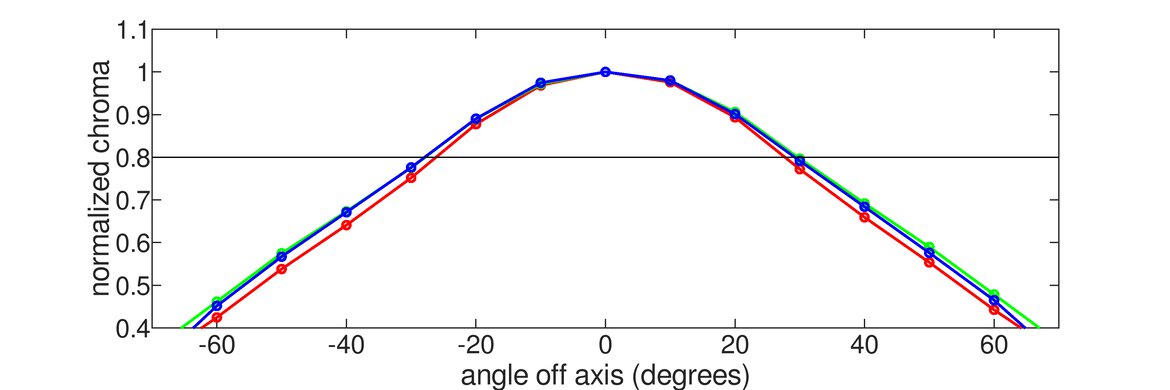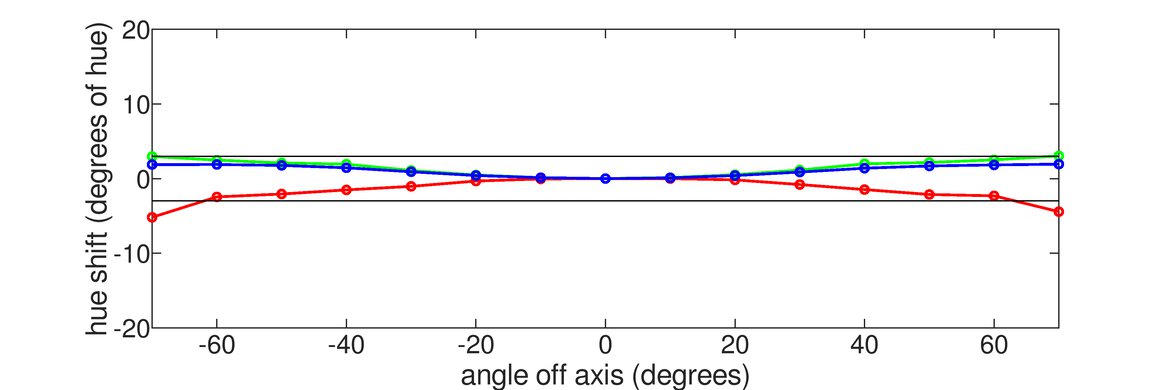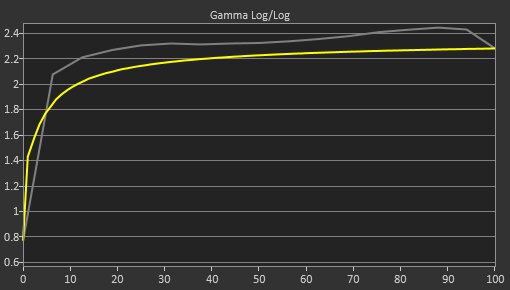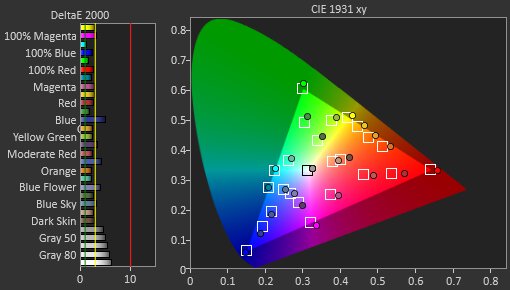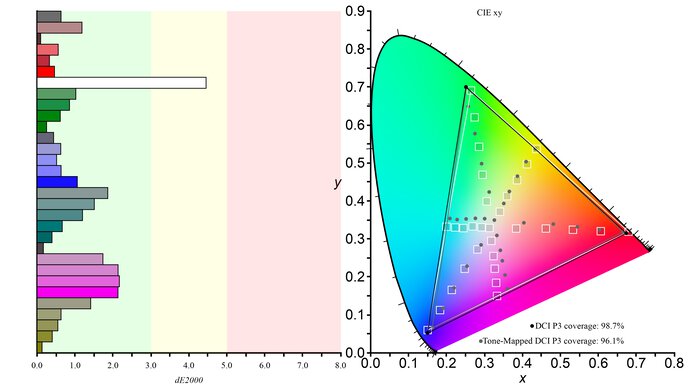The LG 27GR95UM-B is a 27-inch, 4k gaming monitor. It's the first UltraGear gaming monitor to have Mini LED backlighting, as it has 1,560 dimming zones, and it competes with other Mini LED monitors, like the Acer Nitro XV275K P3biipruzx and the INNOCN 27M2V. It has a native 144Hz refresh rate that you can overclock to 160Hz, and it has HDMI 2.1 bandwidth to take advantage of modern graphics cards and consoles. It also has FreeSync Premium Pro and G-SYNC compatibility to reduce screen tearing. Besides that, it has typical gaming features, like Black Stabilizer and Crosshair, to help with your gaming experience, and it supports DTS Headphone:X.
Our Verdict
The LG 27GR95UM is good for PC gaming. Gaming feels responsive thanks to its low input lag and 160Hz refresh rate, and it has a good enough response time to result in minimal motion blur. It also has HDMI 2.1 bandwidth to take advantage of modern graphics cards. However, it has limited picture quality as its local dimming feature is bad, and blacks look gray in dark scenes. That said, it gets bright enough to fight glare if you want to game in a bright room.
-
Overclockable 160Hz refresh rate.
-
Good motion handling.
-
Low input lag.
-
Gets very bright.
-
Bad local dimming feature causes blooming and black crush.
-
Low contrast ratio.
-
Some inverse ghosting at low refresh rates.
The LG 27GR95UM is impressive for console gaming. It has HDMI 2.1 bandwidth to make full use of the PS5 and Xbox Series X|S, and its 4k resolution delivers detailed images. Plus, it has low input lag for a responsive feel, and there's minimal motion blur at most refresh rates. While it's a good choice for gaming in well-lit rooms because of how bright it gets, it's worse in dark rooms. It has a bad local dimming that fails to improve the picture quality in dark scenes and causes blooming and black crush.
-
High 4k resolution.
-
Good motion handling.
-
Low input lag.
-
HDMI 2.1 bandwidth.
-
Gets very bright.
-
Bad local dimming feature causes blooming and black crush.
-
Low contrast ratio.
-
Some inverse ghosting at low refresh rates.
The LG 27GR95UM is great for office use. Its 4k resolution results in sharp text, and it has wide enough viewing angles that keep the image consistent when viewing from the sides, like if you need to share your screen with a coworker. However, it lacks swivel adjustment, so it's hard to turn it. On the plus side, it gets bright enough to fight glare in most well-lit rooms, but its reflection handling is mediocre, so having a bright light shining on the screen is distracting.
-
High 4k resolution.
-
Gets very bright.
-
Wide viewing angles.
-
No swivel adjustment.
-
Mediocre reflection handling.
The LG 27GR95UM is good for editing. It has a high resolution that makes text and images look sharp. It also gets bright enough to fight glare in most well-lit rooms, but reflections are distracting if you have it opposite a bright source. Unfortunately, it's worse for editing content in dark rooms, as it has a low contrast ratio, and its local dimming feature performs terribly.
-
High 4k resolution.
-
Gets very bright.
-
Wide viewing angles.
-
Bad local dimming feature causes blooming and black crush.
-
Mediocre reflection handling.
-
sRGB mode needs full calibration for best accuracy.
The LG 27GR95UM has excellent brightness. It easily gets bright enough to fight glare whether you're using it in SDR or HDR.
-
Gets very bright.
The LG 27GR95UM has good response time. While there isn't much blur with fast-moving objects, it has more inverse ghosting as the refresh rate drops.
-
Good motion handling.
-
Some inverse ghosting at low refresh rates.
The LG 27GR95UM has okay HDR picture quality. It's mainly limited by its low contrast and bad local dimming feature that causes blooming and black crush in dark scenes. That said, it displays a wide range of colors that look vivid.
-
Displays wide range of colors.
-
Bad local dimming feature causes blooming and black crush.
-
Low contrast ratio.
The LG 27GR95UM has decent SDR picture quality. Its main advantage is the wide range of colors that it displays, but blacks look gray due to its low contrast ratio.
-
Displays wide range of colors.
-
Low contrast ratio.
The LG 27GR95UM has very good color accuracy. While it has a dedicated sRGB mode, there are white balance and gamma issues, so you need to calibrate it for the best accuracy.
-
sRGB mode needs full calibration for best accuracy.
- 7.5 PC Gaming
- 8.4 Console Gaming
- 8.2 Office
- 7.7 Editing
Performance Usages
- 8.7 Brightness
- 7.5 Response Time
- 6.7 HDR Picture
- 7.2 SDR Picture
- 7.9 Color Accuracy
Changelog
- Updated Jul 24, 2025: We've converted this review to Test Bench 2.1. This includes new tests for Direct Reflections, Ambient Black Level Raise, and Total Reflected Light. You can see all the changes in the changelog.
-
Updated Jun 20, 2025:
Added to Additional Features that the Samsung Odyssey 3D G90XF S27FG900X can display glasses-free 3D with some games.
-
Updated Mar 31, 2025:
We added that the AOC AGON PRO AG276QZD2 has a higher max refresh rate.
- Updated Feb 21, 2025: We've converted this review to Test Bench 2.0.1. This includes a new test result for DisplayPort 2.1 Transmission Bandwidth.
-
Updated Jan 24, 2025:
Added that the Sony INZONE M9 II has Auto HDR Tone Mapping with the PS5.
Check Price
Differences Between Sizes And Variants
We bought and tested the 27-inch LG 27GR95UM, which has an IPS panel with an ATW Polarizer and is the only size available. There aren't any variants, so the review is only valid for this model.
| Model | Size | Resolution | Max Refresh Rate | Dimming Zones |
|---|---|---|---|---|
| 27GR95UM-B | 27" | 4k | 160Hz | 1,560 |
Our unit's label indicates that it was manufactured in February 2024. We tested it on firmware 3.05, 2.02.
Compared To Other Monitors
The LG 27GR95UM is a premium 4k gaming monitor with an overclockable 160Hz refresh rate and HDMI 2.1 bandwidth. It's the first LG monitor with Mini LED backlighting, and it has 1,560 dimming zones. That said, its local dimming feature performs badly, as it makes the picture quality worse with noticeable blooming and black crush. There are other Mini LED monitors with better local dimming features, like the Acer Nitro XV275K P3biipruzx and the INNOCN 27M2V. On top of that, the LG tends to be expensive, so it may be worth considering an OLED with much better picture quality if your budget allows for it.
Also see our recommendations for the best Mini LED monitors, the best HDR monitors, and the best 4k 144Hz monitors.
The LG 27GR95UM-B and the Acer Nitro XV275K P3biipruzx are both 4k gaming monitors with Mini LED backlighting. They have many of the same specs, but the Acer has a few advantages in terms of performance. The Acer has a better local dimming feature than the LG, with less blooming and black crush, and it has better motion handling too. The Acer also has some extra features, like a KVM switch and USB-C, making it the better choice for productivity. However, the LG is the better choice for console gaming at 60Hz thanks to its lower input lag at that refresh rate.
The LG 27GP950-B and the LG 27GR95UM-B are both 4k gaming monitors in the LG UltraGear lineup, but there are a few differences. The 27GR95UM-B uses Mini LED backlighting, and even though its local dimming feature is better than on the 27GP950-B, it performs badly. One advantage of the 27GR95UM-B is that it gets much brighter, ideal for using it in a well-lit room.
The Cooler Master Tempest GP27U and the LG 27GR95UM-B are both 4k gaming monitors with similar specs. They each have Mini LED backlighting, and even though the Cooler Master has fewer dimming zones, its local dimming feature is better with less blooming and black crush. On top of that, the Cooler Master is better for productivity thanks to its KVM switch and USB-C port.
The LG 27GR95UM-B and the INNOCN 27M2V are 4k gaming monitors with Mini LED backlighting and similar features. However, there are a few differences in performance, as the INNOCN has a better local dimming feature, more accurate colors, and better motion handling. However, the LG has a lower input lag at 60Hz, making it the better choice for gaming at that refresh rate.
Video
Test Results
The ergonomics are decent. You can adjust it in a number of ways, including vertically, but without any swivel adjustment, it's harder to turn the screen for someone next to you. There's also a clip on the stand for basic cable management.
The full-array local dimming feature is bad. Although it uses Mini LED backlighting with 1,560 small zones, it's ineffective and actually makes the picture quality worse with it on. There's a lot of black crush, so it's hard to see any details in dark scenes, and bright objects and subtitles cause a ton of blooming. It even struggles to keep the black level uniform throughout, as it looks blotchy with real content.
There are three Local Dimming settings, with 'Normal' and 'Fast' performing similarly, and 'Faster' being the most aggressive with the most black crush, but also results in the brightest image.
You can see different examples of real content with Local Dimming set to 'Off' and 'Faster':
Settings
- Game Mode: Gamer 1 (after calibration)
- Brightness: 100
- Peak Brightness: High
- Local Dimming: Faster
The SDR brightness is excellent. It easily gets bright enough to fight glare, and while there's some changes in brightness between different content, it isn't distracting. If you're sensitive to bright lights and you're using the monitor in a bright room, turning Peak Brightness off with any of the Local Dimming settings enabled allows it to achieve its lowest minimum brightness.
You can see more results with different Peak Brightness settings, keeping the other settings the same:
| Peak Brightness | Off | Low |
|---|---|---|
| Real Scene | 444 cd/m2 | 445 cd/m2 |
| Peak 2% Window | 279 cd/m2 | 653 cd/m2 |
| Peak 10% Window | 396 cd/m2 | 709 cd/m2 |
| Peak 25% Window | 451 cd/m2 | 447 cd/m2 |
| Peak 50% Window | 470 cd/m2 | 467 cd/m2 |
| Peak 100% Window | 479 cd/m2 | 476 cd/m2 |
| Sustained 2% Window | 279 cd/m2 | 653 cd/m2 |
| Sustained 10% Window | 396 cd/m2 | 709 cd/m2 |
| Sustained 25% Window | 450 cd/m2 | 447 cd/m2 |
| Sustained 50% Window | 470 cd/m2 | 467 cd/m2 |
| Sustained 100% Window | 479 cd/m2 | 475 cd/m2 |
| Automatic Brightness Limiting (ABL) | 0.033 | 0.030 |
Settings
- Game Mode: Gamer 2
- Brightness: 100
- Peak Brightness: High
- Local Dimming: Faster
The HDR brightness is amazing. It gets bright enough to fight glare if you want to watch content in bright rooms, but because it keeps this brightness the same across different scenes, small highlights don't really stand out. Its PQ EOTF tracking also has a slow roll-off at its peak brightness, so it doesn't let highlights get the brightest they could. Plus, real content looks worse than what the test slides show, as the local dimming fails to improve the picture quality in HDR, and even causes black crush.
You can see more results with different Local Dimming and Peak Brightness settings below:
| Peak Brightness | Off | Low | High |
|---|---|---|---|
| Local Dimming | Faster | Faster | Off |
| Real Scene | 832 cd/m2 | 814 cd/m2 | 818 cd/m2 |
| Peak 2% Window | 508 cd/m2 | 1,087 cd/m2 | 852 cd/m2 |
| Peak 10% Window | 717 cd/m2 | 1,225 cd/m2 | 854 cd/m2 |
| Peak 25% Window | 816 cd/m2 | 1,334 cd/m2 | 854 cd/m2 |
| Peak 50% Window | 851 cd/m2 | 1,398 cd/m2 | 854 cd/m2 |
| Peak 100% Window | 866 cd/m2 | 1,422 cd/m2 | 854 cd/m2 |
| Sustained 2% Window | 508 cd/m2 | 1,079 cd/m2 | 852 cd/m2 |
| Sustained 10% Window | 716 cd/m2 | 1,206 cd/m2 | 853 cd/m2 |
| Sustained 25% Window | 816 cd/m2 | 808 cd/m2 | 854 cd/m2 |
| Sustained 50% Window | 850 cd/m2 | 846 cd/m2 | 853 cd/m2 |
| Sustained 100% Window | 865 cd/m2 | 862 cd/m2 | 854 cd/m2 |
| Automatic Brightness Limiting (ABL) | 0.030 | 0.023 | 0.000 |
The horizontal viewing angle is okay. While the image gets darker at wide angles, it’s still fine for sharing the screen with someone next to you.
The vertical viewing angle is good. The image remains consistent whether you’re viewing it from above or below.
The accuracy before calibration is decent. Although it has a dedicated sRGB mode that locks colors fairly well to the sRGB color space, it still has issues with the white balance and gamma tracking. Plus, the color temperature is on the warm side, giving the image a red tint. Unfortunately, other modes are less accurate with more oversaturated colors.
The sRGB mode locks you out of a few settings, including:
- Black Stabilizer
- Response Time
- Black Level
- Color Temp
- Gamma
- Sharpness
- R/G/B
- Six Color
- Smart Energy Saving
The accuracy after calibration is remarkable. Calibrating it fixes any issues that occur before calibration, and it gives you access to the settings that are locked out in the sRGB mode.
The SDR color gamut is fantastic. It displays the sRGB color space perfectly, and it also has very wide coverage of the Adobe RGB color space used in content creation, but it oversaturates most colors and undersaturates cyan.
The text clarity is fantastic. Even with ClearType off (bottom photo), text looks sharp, and enabling it makes letters look bolder (top photo). These photos are in Windows 10, and you can also see them in Windows 11 with ClearType on and with ClearType off.
This monitor has a native 144Hz refresh rate that you can boost to 160Hz using the Overclock setting. If you want a monitor with a higher 240Hz refresh rate, take a look at the AOC AGON PRO AG276QZD2.
| NVIDIA - G-SYNC Compatibility | ||
|---|---|---|
| Connection | VRR Min | VRR Max |
| DisplayPort | <20Hz | 160Hz |
| HDMI | <20Hz | 160Hz |
| AMD - FreeSync | ||
|---|---|---|
| Connection | VRR Min | VRR Max |
| DisplayPort | <20Hz | 160Hz |
| HDMI | <20Hz | 160Hz |
On top of supporting FreeSync VRR and G-SYNC compatibility, this monitor also supports HDMI Forum VRR.
| Frame Rate | CAD Heatmap | RT Chart | Pursuit Photo |
|---|---|---|---|
| 159 | Heatmap | Chart | Photo |
| 144 | Heatmap | Chart | Photo |
| 120 | Heatmap | Chart | Photo |
| 100 | Heatmap | Chart | Photo |
| 80 | Heatmap | Chart | Photo |
| 60 | Heatmap | Chart | Photo |
The LG 27GR95UM has good motion handling across its VRR range. The 'Fast' Overdrive setting has the best motion handling at most refresh rates, but it has a bit more inverse ghosting as the refresh rate drops. If that bothers you, the 'Off' and 'Normal' settings are more consistent over the refresh rate range but have more blur. The 'Faster' overdrive has such high CAD that it passes the limits of the chart, as you can see in an alternative chart.
The refresh rate compliance is good. Although its response time isn’t fast enough to make full color transitions before the monitor draws the next frame at its max refresh rate, it’s much better at low refresh rates.
| Overdrive Mode | CAD Heatmap | RT Chart | Pursuit Photo |
|---|---|---|---|
| Off | Heatmap | Chart | Photo |
| Normal | Heatmap | Chart | Photo |
| Fast | Heatmap | Chart | Photo |
| Faster | Heatmap | Chart | Photo |
The CAD at the max refresh rate of 160Hz is good. Although there's a bit of blur with the 'Fast' overdrive setting, it doesn't have any noticeable inverse ghosting like 'Faster.'
| Overdrive Mode | CAD Heatmap | RT Chart | Pursuit Photo |
|---|---|---|---|
| Off | Heatmap | Chart | Photo |
| Normal | Heatmap | Chart | Photo |
| Fast | Heatmap | Chart | Photo |
| Faster | Heatmap | Chart | Photo |
The CAD at 120Hz is good. It performs similarly to its max refresh rate, with the 'Fast' overdrive setting having some blur but less inverse ghosting than 'Faster.'
You can't select a 120Hz refresh rate in the monitor's EDID over DisplayPort, and the only ways to get 120Hz are either over HDMI or using VRR to go down to 120Hz. Motion looks the same whether you use VRR or not.
This monitor doesn’t have an optional backlight strobing feature to reduce persistence blur.
The LG 27GR95UM has very low input lag no matter the refresh rate, so gaming feels responsive.
If you're looking for a monitor that has Auto HDR Tone Mapping with the PS5, check out the Sony INZONE M9 II.
While the monitor supports any signal from the Xbox Series X|S, you need to enable the console’s HDMI override setting for 1440p @ 60Hz to work, which disables VRR. Keep in mind that the Xbox doesn’t support HDR with 1080p or 1440p signals, so this isn’t a limitation of the monitor.
The 3.5 mm audio output serves as a combo jack with audio out and mic in, but you need to have the USB-B cable connected to your computer to fully use it. It also comes with DTS Headphone:X to simulate surround sound audio.
| Connection | HDMI 2.0 | HDMI 2.1 | USB-C to DP |
|---|---|---|---|
| Max Refresh Rate | 60Hz | 160Hz | 160Hz (M2) 144Hz (M1) |
| VRR Range | N/A | 48-144Hz | 48-160Hz (M2) 48-144Hz (M1) |
| HDR | Yes | Yes | Yes |
The LG 27GR95UM works well with macOS. The monitor's overclock doesn't work with all connections, but other than that, there aren't any obvious issues. If you’re using a MacBook, you can close the lid and continue working on the screen, and after reopening the lid, windows return to their original positions.
This monitor has a few extra features, including:
- Black Stabilizer: Adjusts the gamma so that it's easier to see opponents in dark areas.
- Crosshair: Adds a virtual crosshair that your game's anti-cheat tool won't detect, giving you a competitive advantage.
- FPS Counter: Displays the current frame rate of your source.
- DTS Headphone:X: The monitor offers a few different sound modes to use with compatible devices.
- Hexagon Lighting: This is the setting to adjust the RGB lighting on the back of the monitor.
- Peak Brightness: Makes the screen the brightest possible.
- Waves MaxxAudio: It supports Waves MaxxAudio, which can enhance audio and be turned on or off.
If you want a monitor that can display glasses-free 3D with some games, check out the Samsung Odyssey 3D G90XF S27FG900X.
Comments
LG 27GR95UM-B: Main Discussion
Let us know why you want us to review the product here, or encourage others to vote for this product.
- 21010
The battery life is a bit on the shorter side [the Bowers and Wilkins also has a similar battery life, right?]. How bulky is the case; bulkier than the Sennheiser Momentum True Wireless 4?
Howdy, thanks for dropping by. Here’s a link to a side-by-side comparison of the products you’ve mentioned. The Devialet, B&W, and Sennheiser are sitting at 4.4hrs, 3.0hrs, and 7.3hrs of battery life with ANC on respectively. And the Devialet’s case is about 36% smaller than the Sennheiser’s. If you’re looking for something with longer battery life in a similar price segment it might be worth checking out the Sony WF-1000XM5 Truly Wireless. Hope this helps 8).
Edited 5 months ago: Hyperlinking - 21010
The battery life is a bit on the shorter side [the Bowers and Wilkins also has a similar battery life, right?]. How bulky is the case; bulkier than the Sennheiser Momentum True Wireless 4?
Update: The following test groups have been updated following Test Bench 1.7: Noise Isolation - Full Range, Noise Isolation - Common Scenarios, and ANC Wind Handling. Several Sound tests have also been updated following Test Bench 1.8. There have also been text changes made throughout the review, including to the usages and product comparisons to match these results.
- 21010
The battery life is a bit on the shorter side [the Bowers and Wilkins also has a similar battery life, right?]. How bulky is the case; bulkier than the Sennheiser Momentum True Wireless 4?
Howdy, thanks for dropping by. Here’s a link to a side-by-side comparison of the products you’ve mentioned. The Devialet, B&W, and Sennheiser are sitting at 4.4hrs, 3.0hrs, and 7.3hrs of battery life with ANC on respectively. And the Devialet’s case is about 36% smaller than the Sennheiser’s. If you’re looking for something with longer battery life in a similar price segment it might be worth checking out the Sony WF-1000XM5 Truly Wireless. Hope this helps 8).
Edited 5 months ago: Hyperlinking - 21010
The battery life is a bit on the shorter side [the Bowers and Wilkins also has a similar battery life, right?]. How bulky is the case; bulkier than the Sennheiser Momentum True Wireless 4?
Update: The following test groups have been updated following Test Bench 1.7: Noise Isolation - Full Range, Noise Isolation - Common Scenarios, and ANC Wind Handling. Several Sound tests have also been updated following Test Bench 1.8. There have also been text changes made throughout the review, including to the usages and product comparisons to match these results.













